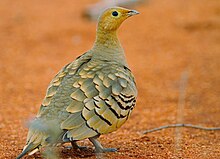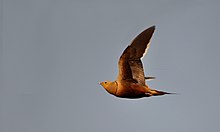| Revision as of 20:26, 25 August 2015 editTWaMoE (talk | contribs)151 edits No reason given← Previous edit | Revision as of 23:39, 27 August 2015 edit undoArchon 2488 (talk | contribs)Extended confirmed users19,915 editsm this is the MOSNUM-preferred unit presentation styleNext edit → | ||
| Line 16: | Line 16: | ||
| | binomial_authority = (], 1825) | | binomial_authority = (], 1825) | ||
| }} | }} | ||
| The '''chestnut-bellied sandgrouse''' (''Pterocles exustus'') is a species of ]. They are found in sparse, bushy, arid land which is common in central and northern Africa, and southern Asia. Though they live in hot, arid climates, they are highly reliant on water. They have been known to travel up to {{convert|50|mi|km}} in one day in search of water. All species of sandgrouse that have been studied in habitat have proved to entirely vegetarian throughout their lives, specialising in leguminous weed seeds and seldom eating grass seeds. | The '''chestnut-bellied sandgrouse''' (''Pterocles exustus'') is a species of ]. They are found in sparse, bushy, arid land which is common in central and northern Africa, and southern Asia. Though they live in hot, arid climates, they are highly reliant on water. They have been known to travel up to {{convert|50|mi|km|order=flip}} in one day in search of water. All species of sandgrouse that have been studied in habitat have proved to entirely vegetarian throughout their lives, specialising in leguminous weed seeds and seldom eating grass seeds. | ||
| ] | ] | ||
Revision as of 23:39, 27 August 2015
| Chestnut-bellied sandgrouse | |
|---|---|

| |
| Conservation status | |
 Least Concern (IUCN 3.1) | |
| Scientific classification | |
| Kingdom: | Animalia |
| Phylum: | Chordata |
| Class: | Aves |
| Order: | Pteroclidiformes |
| Family: | Pteroclididae |
| Genus: | Pterocles |
| Species: | P. exustus |
| Binomial name | |
| Pterocles exustus (Temminck, 1825) | |
The chestnut-bellied sandgrouse (Pterocles exustus) is a species of sandgrouse. They are found in sparse, bushy, arid land which is common in central and northern Africa, and southern Asia. Though they live in hot, arid climates, they are highly reliant on water. They have been known to travel up to 80 kilometres (50 mi) in one day in search of water. All species of sandgrouse that have been studied in habitat have proved to entirely vegetarian throughout their lives, specialising in leguminous weed seeds and seldom eating grass seeds.


In the 1960s many birds were captured using clap traps from Rajasthan in India and introduced into Nevada. They have also been introduced to Hawaii.
A subspecies, P. e. floweri, was last seen in the Nile Valley of Egypt in 1979. It is thought to be extinct, but the reasons for this are unknown.
References
- Template:IUCN
- Christensen, Glen C. (1962) Use of the Clap Net for Capturing Indian Sand Grouse. The Journal of Wildlife Management. 26(4):399–402.
- Hume, J. P.; Walters, M. (2012). Extinct Birds. London: A & C Black. p. 133. ISBN 1-4081-5725-X.
External sources
This bird-related article is a stub. You can help Misplaced Pages by expanding it. |